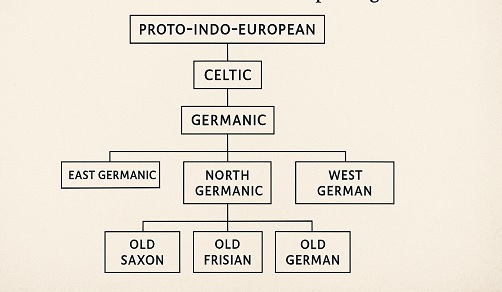
If you want to understand modern German, you need to start before Germany even existed. Long before “Guten Tag” became part of everyday speech, the German language was forming from the scattered sounds of tribal tongues and Indo-European roots. The story begins in the mists of prehistory – and it travels through sound shifts, migrations, and oral tradition to arrive at what linguists now call Old High German.
This article traces the birth of the German language, focusing on its evolution from Proto-Indo-European through Proto-Germanic to the first written forms of German as we recognize them today. It’s the linguistic deep dive that explains why German sounds the way it does – and why it still carries the echoes of a tribal past.
Proto-Indo-European: The Distant Ancestor
The roots of the German language stretch back over 5,000 years to a hypothesized language called Proto-Indo-European (PIE). This ancient tongue is the common ancestor of many European and South Asian languages – including Latin, Greek, Sanskrit, Celtic, Slavic, and of course, Germanic.
While no written records of PIE exist, linguists have reconstructed large parts of it using comparative methods. Common vocabulary themes like family (mater, pater), numbers, and natural elements hint at shared origins. Around 3000 BCE, this language began to splinter as its speakers migrated across Europe and Asia.
One of these offshoots became Proto-Germanic.
Proto-Germanic: A Tribal Identity Forms
By around 500 BCE, the Germanic tribes of northern Europe – including what is now southern Scandinavia, northern Germany, and the Netherlands – were speaking a distinct branch of Indo-European.
Proto-Germanic was never written down, but we know a great deal about it through linguistic reconstruction and early borrowings into Latin. It is during this stage that several key features of Germanic languages emerged:
- Grimm’s Law: A famous set of sound shifts named after the Brothers Grimm, who were linguists as well as folklorists. For example:
- PIE p becomes f (Latin pater → English father, German Vater)
- PIE t becomes th (Latin tres → English three, German drei)
- The use of strong and weak verbs (e.g., singen – sang – gesungen)
- The development of compound words and complex inflectional systems
This was the linguistic bedrock on which all Germanic languages were built, including English, Dutch, and German.
Contact with Rome: Borrowings and Boundaries
As Roman legions pushed into Germania, they brought with them Latin vocabulary, culture, and new ideas. While the Germanic tribes were never fully conquered, they did adopt many Latin loanwords – especially in areas like trade, technology, and religion.
Examples include:
- Latin caupona → German Kaufmann (merchant)
- Latin vinum → German Wein (wine)
At the same time, the encounter with Rome solidified a sense of Germanic linguistic and cultural identity in opposition to Latin-speaking outsiders.
Runes: The First Writing System
The earliest evidence of written Germanic comes not in German, but in the form of runic inscriptions. The runic alphabet (Futhark) was likely adapted from the Etruscan or Latin scripts around the 2nd century CE.
Runes were used by various Germanic tribes – especially in Scandinavia – and often appear on weapons, stones, and jewelry. These inscriptions are brief and formulaic, but they mark the beginning of written Germanic expression.
In German-speaking regions, runes were gradually replaced by the Latin alphabet as Christianity spread. This transition set the stage for the next major phase: Old High German.
What Is Old High German?
Old High German (OHG) refers to the dialects spoken in southern and central parts of the Germanic world between roughly 500 and 1050 CE. It marks the point where German becomes a distinct, written language.
It’s called “High” German because it originated in the highlands of southern Germany, Austria, and Switzerland – in contrast to “Low” German (Plattdeutsch) spoken in the northern lowlands.
Key Features of Old High German:
- Strong inflection: nouns, verbs, adjectives, and articles were all heavily declined
- Different word order than modern German
- Use of diacritical marks like the “macron” to indicate long vowels
- No standardized spelling – each region had its own way
Texts That Define the Era
- The Hildebrandslied (c. 830): A heroic epic in alliterative verse, one of the oldest surviving texts in Old High German.
- The Wessobrunn Prayer: A mix of Christian and pagan elements, it reflects the spiritual transition of early medieval Germany.
- Notker Balbulus’ translations: A monk at the Abbey of Saint Gall who translated Latin texts into Old High German, helping to standardize grammar and vocabulary.
These texts were typically written in monasteries, as monks were among the few literate members of society. This also meant that Latin remained dominant in formal education and theology, while Old High German was the vernacular.
Dialects in OHG
There was no single Old High German – rather, it was a collection of regional dialects:
- Alemannic (southern Germany and Switzerland)
- Bavarian (southern Germany and Austria)
- Frankish (west-central Germany)
- Thuringian (central Germany)
These dialects would later influence the shape of Middle High German and eventually Modern Standard German.
Why This Era Matters
Old High German laid the groundwork for the modern German language. It introduced key grammatical structures, vocabulary, and literary forms that would evolve over the centuries.
It also captures a society in transition: from oral to written culture, from paganism to Christianity, from tribal autonomy to feudal rule. Language, as always, was at the heart of these changes.
Related articles:
➡️ The Evolution of the German Language: A Cultural History
➡️ Luther’s Language Legacy: How One Translation Shaped German
➡️ Dialects vs. Standard German: Why Both Still Matter
➡️ From Poets to Politicians: German’s Role in Identity and Nation-Building
➡️ Global German: How the Language Travels the World Today
Next in the Series ➡️ Luther’s Language Legacy: How One Translation Shaped German
